Hoang Phap Buddhist temple, nestled in the bustling city of Ho Chi Minh City, is a serene oasis that offers visitors a tranquil escape from the urban hustle and bustle. Unlike the Jade Emperor Pagoda, which bears the hallmark of Chinese architecture, at Hoang Phap Pagoda, tourists can behold and immerse themselves in the essence of Vietnamese culture.
1. An overview of Hoang Phap Buddhist Temple
- Address: Thanh Ong Nam Ward, Tan Hiep Commune, Hoc Mon District, Ho Chi Minh City
Hoang Phap Buddhist Temple is one of the most famous Vietnamese pagodas in Ho Chi Minh City and holds a significant presence with its rich history spanning over five decades. Revered for its natural beauty and the profound teachings of its founding patriarch, the temple attracts devout Buddhists and seekers of spiritual enlightenment from Saigon and beyond.
The temple’s lush surroundings, adorned with towering trees that cast calming shadows, create an atmosphere conducive to introspection and meditation. Beyond its scenic allure, Hoang Phap Buddhist Temple is a beacon of Buddhist wisdom, providing a haven for pilgrims to immerse themselves in its spiritual offerings.
At its core, the temple fosters a vibrant community of practitioners committed to pursuing enlightenment. Whether seeking solace amidst its serene ambiance or guidance along the path of enlightenment, Hoang Phap Buddhist Temple stands as a timeless testament to faith, compassion, and harmony amidst the chaos of modern life.
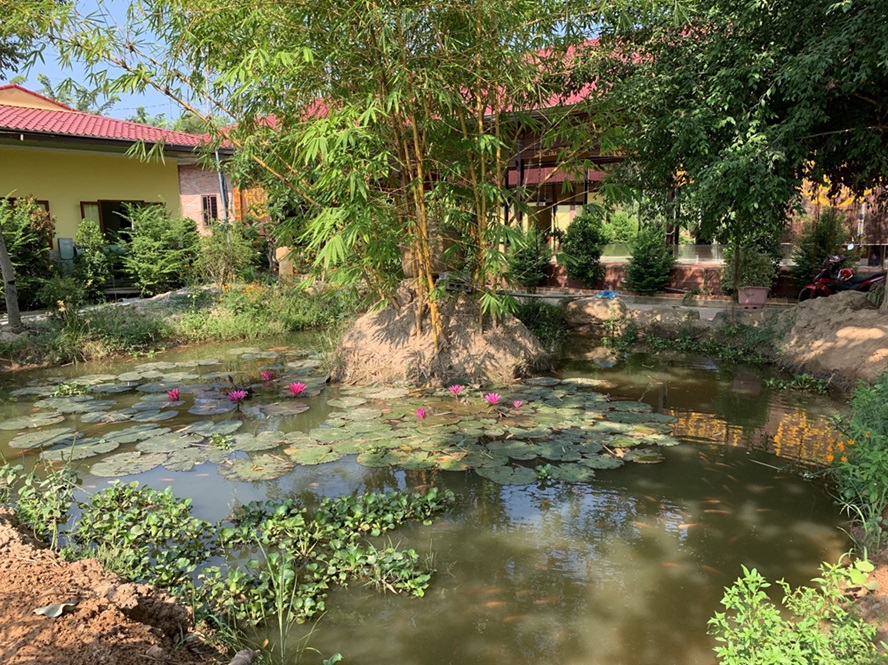
Hoang Phap Pagoda is where individuals can deepen their understanding of Buddhist principles and cultivate inner peace (Source: Collected)
Read more: 20 places to visit in Ho Chi Minh City for your itinerary
2. The history of Hoang Phap Buddhist Temple
Hoang Phap Pagoda, a sacred site belonging to the Northern Buddhist sect, was established by Venerable Ngo Chan Tu in 1957 amidst the lush forest. Construction of the pagoda commenced in 1959, featuring brick walls, two red-tiled roofs, and an orientation towards the northwest.
In 1965, the conflict in Dong Xoai, Thuan Loi, displaced many families, prompting the pagoda’s abbot to shelter 60 families and subsequently acquire land to build 55 homes for resettlement. In 1968, the Duc Anh Institute was founded within the pagoda’s premises, providing care and education to 365 children. Through charitable endeavors, the pagoda has undergone numerous enhancements and expansions.
Since 2005, the pagoda has hosted a summer retreat for students, with nearly 6,000 participants annually. Today, Hoang Phap Pagoda is considered the largest center for Buddhist study and culture in Vietnam.
Read more about the Xa Loi Buddhist Temple for a better understanding of the Buddhist region in Vietnam
3. Architectural highlights of Hoang Phap Buddhist Temple
3.1. The I-shaped structure
During the 1995 renovation, the Bhadanta expanded the Buddha Hall to a width of 18 meters and a length of 42 meters, totaling 756 square meters, all in an I-shaped architectural style. Despite the modern construction approach, the hall retained the traditional appearance of Northern pagodas.
The entire structure, including the foundation, beams, pillars, ceiling, and roof, was constructed using durable concrete. Enameled tiles adorned the exterior walls, while the interior walls were painted. The floor was elegantly paved with granite imported from Spain. Crafted from precious wood, all doors, balconies, and altars were skillfully engraved.
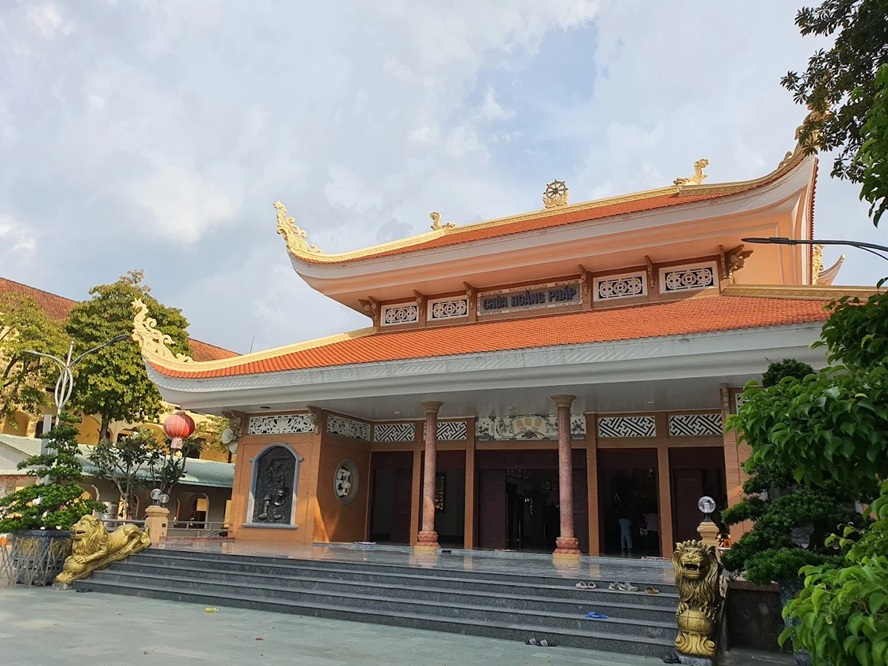
Hoang Phap Buddhist temple features gracefully curved corners and two stories covered by red-tiled roofs (Source: Collected)
3.2. The reliefs and statues
Hoang Phap Buddhist Temple boasts a stunning array of reliefs and statues that adorn its sacred halls, each contributing to the rich tapestry of Buddhist art and spirituality. As visitors ascend the stairs to the Buddha Hall, they are greeted by the imposing presence of two cement lion statues, symbolizing strength and protection in the Buddhist tradition.
Flanking the hall’s entrance are relief statues of Vajra Bodhisattvas, their grave countenances, and their powerful physiques. Inside the Buddha Hall, the focal point is the majestic Buddha seated upon a lotus throne. This awe-inspiring statue, standing approximately 4.5 meters tall, serves as a visual representation of enlightenment and compassion.
Surrounding the hall’s walls, intricately crafted relief statues depict pivotal moments from the Buddha’s life. These statues offer devotees a profound visual journey through the teachings and experiences of the Enlightened One.
3.3. The parallel verses
Before the altar, a wooden balcony, intricately carved with “nine dragons attending the moon,” rests gracefully. Above this balcony, three wooden Chinese scrolls are prominently displayed. The central scroll bears the inscription “SASTA SEVAMANUSYANAM” (Teacher of devas and men), while the others are named “MERCY” and “INTELLIGENCE.”
Observing from outside, the main gate proudly showcases the words “Hoang Phap Pagoda,” while the left-side gate is adorned with “MERCY,” and the right one with “INTELLIGENCE.” Alongside both the main and side gates, inscriptions in Vietnamese elegantly underscore the significance of Hoang Phap Pagoda and the invaluable teachings of Buddhism.
3.4. The towers
Apart from Buddha statues, Hoang Phap Pagoda also boasts several towers that showcase the distinctive architecture of Vietnamese Buddhism. On the left side of the main hall, as viewed from the exterior, stands the “Nhị Nghiêm” tower, housing the body of the late venerable Master Ngo Chan Tu. Nearby is the tower dedicated to the temple’s venerable monks.
Additionally, there is the Enlightenment Tower, preserving the ashes of the twelve esteemed Buddhist disciples. Behind the main hall is the Monk’s hall, a lecture hall capable of accommodating over 300 attendees. In front of the Monk’s hall are two lush green lawns adorned with ancient tamarind trees, creating a tranquil ambiance.
3.5. The miniature landscapes
To the right of the Buddha Hall, when viewed from outside, lies a garden adorned with lush green grass. Adjacent to the bamboo grove stood a towering rock formation, stretching 10 meters in height and 20 meters in width, resting upon a tranquil lake. Dominating the scene was a magnificent 5-meter marble statue of Avalokitesvara Bodhisattva, now considered one of the most exquisite rock sculptures in Ho Chi Minh City.
Following this centerpiece was a smaller rock formation nestled within a circular pond. Behind it stood the Salvaged Stupa, housing the remains of sentient beings. In the foreground, two patches of verdant grass framed a venerable tamarind tree, its age apparent in its gnarled branches.
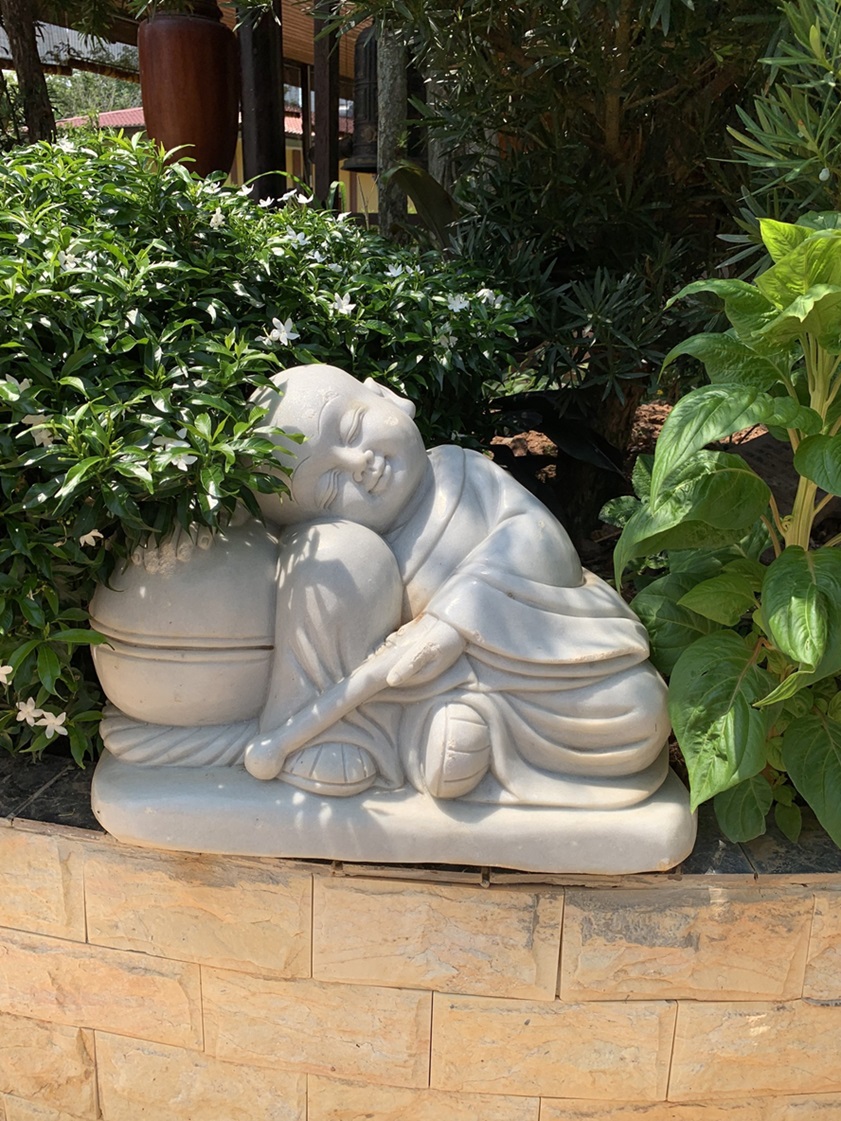
Hoang Phap Buddhist Temple has one of the most beautiful miniature rock-works in Ho Chi Minh City (Source: Collected)
4. Things to do while visiting Hoang Phap Buddhist Temple
4.1. Admire the architecture and take photos
Visiting the Hoang Phap Buddhist Temple offers a captivating experience of admiring its remarkable architecture. As you step through the entrance, the traditional yet modern design of the temple’s gate, adorned with intricate details and curved lines, immediately captures your attention.
The vibrant red roof tiles and gracefully arched doorways evoke a sense of reverence and tranquility. Each element of the temple’s structure, from the majestic main hall to the serene courtyards, reflects a harmonious blend of tradition and innovation.
While exploring the temple grounds, remember to capture the beauty of its architecture through your lens. Every angle presents a unique perspective, whether the ornate carvings on the pillars or the sweeping curves of the roofs against the azure sky. Take your time to appreciate the craftsmanship and dedication that went into crafting this spiritual sanctuary.
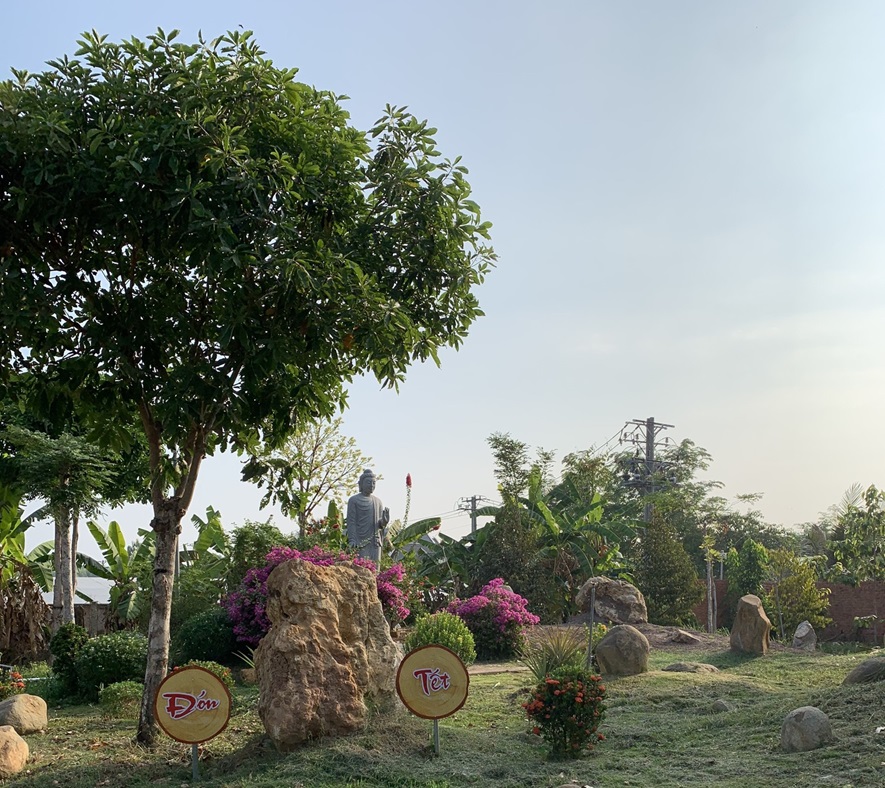
A multitude of trees and plants cover the courtyard of Hoang Phap Buddhist Temple (Source: Collected)
4.2. Pray for good luck under the ashoka tree
Hoang Phap Buddhist Temple is well-known for its incredibly auspicious “Vo Uu” tree (ashoka tree). This ancient species bears clusters of flowers that gracefully hang down, displaying mesmerizing red petals. It is a common sight in many Vietnamese temples.
According to ancient legend, it was under the Vo Uu tree that the Buddha Shakyamuni was born. Therefore, this tree is believed to bring about good fortune. Buddhists from all corners often gather at Hoang Phap Temple to pray beneath the Vo Uu tree, seeking blessings and tranquility for their families.
Don’t forget to explore things to do in Ho Chi Minh City before traveling and enjoy the most of this city!
5. Guide to visit Hoang Phap Buddhist Temple
5.1. When is the best time to visit?
In addition to the meditation retreats, major festivals at the temple also attract many visitors. You can visit Hoang Phap Buddhist Temple on the following holidays to experience many interesting cultural activities!
- Ancestor Worship Day: This festival is held annually on the 15th day of the first lunar month.
- Vesak Day: Celebrated on the 15th day of the fourth lunar month, Vesak Day commemorates and pays tribute to the great enlightenment of Lord Buddha.
- “Quy Y Tam Bao” Ceremony: This ceremony, held three times a year at Hoang Phap Temple, establishes a solid foundation for faith and provides the prerequisite conditions for practicing the correct Dharma.
- Ancestral Anniversary: This festival is held on the 16th day of the 10th lunar month to honor the founder of Hoang Phap Temple, allowing the monks to express gratitude for his contributions.
- Lantern Night in Commemoration of Buddha Amitabha: Held on the 17th day of the 11th lunar month in the evening, this lantern night aims to spread the message of enlightenment and the teachings of Buddhism.
5.2. How to get there?
Hoang Phap Buddhist Temple lies about 20 kilometers northwest of the city center. Visitors have multiple transportation options to reach the temple, including motorbikes, cars, or buses. The route is straightforward and easily accessible. Here are the directions:
Personal vehicles:
- Begin your journey from Ben Thanh Market in District 1 towards Truong Dinh Street alongside the Nhieu Loc – Thi Nghe Canal.
- Continue onto Truong Sa Street, then straight onto Cong Hoa Avenue until you reach Truong Chinh Street.
- After passing through the An Suong underpass onto Xuyen A Street, continue to Tan Hiep commune in Hoc Mon district.
- From there, you can utilize Google Maps or ask locals for guidance at Hoang Phap Buddhist Temple.
Public transportation: Opt for buses like 04, 14, 74, or 94. Upon boarding, inquire with the bus driver about the closest stop to Hoang Phap Buddhist Temple.
5.3. Important notes for visitors
- Opening hours: Hoang Phap Pagoda welcomes visitors from 5:00 AM to 8:30 PM.
- Maintain silence: Upon arrival, please maintain a quiet atmosphere and refrain from loud conversations or laughter to uphold the tranquility of the pagoda.
- Respectful attire: As a place of spiritual reverence, it is essential to dress modestly. Long-sleeved clothing is recommended, and avoid wearing tight, revealing, or short attire.
- Cultural sensitivity: Be mindful of artistic practices and customs. Show respect towards the pagoda’s surroundings and fellow visitors.
- Enjoy your visit: Embrace the serenity and spirituality of the pagoda while being mindful of its rules and guidelines.
Check the Ho Chi Minh City map and plan the best itinerary!
Hoang Phap Buddhist Temple is a serene sanctuary that invites travelers to immerse themselves in its spiritual ambiance and rich cultural heritage. The pagoda’s picturesque surroundings and tranquil atmosphere offer a profound sense of peace and introspection. Visitors are encouraged to explore its magnificent architecture, participate in traditional ceremonies, and engage in quiet contemplation.
After experiencing the serene beauty of Hoang Phap Pagoda, travelers can embark on a journey to explore other captivating destinations across Vietnam, such as Hanoi, Ha Long, Hoi An, Nha Trang, Phu Quoc, etc.
If you are more into excitement and entertainment, explore the thrill of VinWonders, the leading entertainment brand in prominent tourist destinations. These amusement parks offer an unforgettable adventure filled with exhilarating activities for you, your family, and friends to enjoy together. Don’t forget to enhance your stay in these destinations by indulging in the exceptional hotels and resorts of Vinpearl.
Book tickets to VinWonders Phu Quoc, Nha Trang, Nam Hoi An, VinKE & Vinpearl Aquarium and VinWonders Wave Park & Water Park and maximize your experience in Vietnam!
 en
en







 Tiếng Việt
Tiếng Việt  中文 (中国)
中文 (中国)  한국어
한국어 
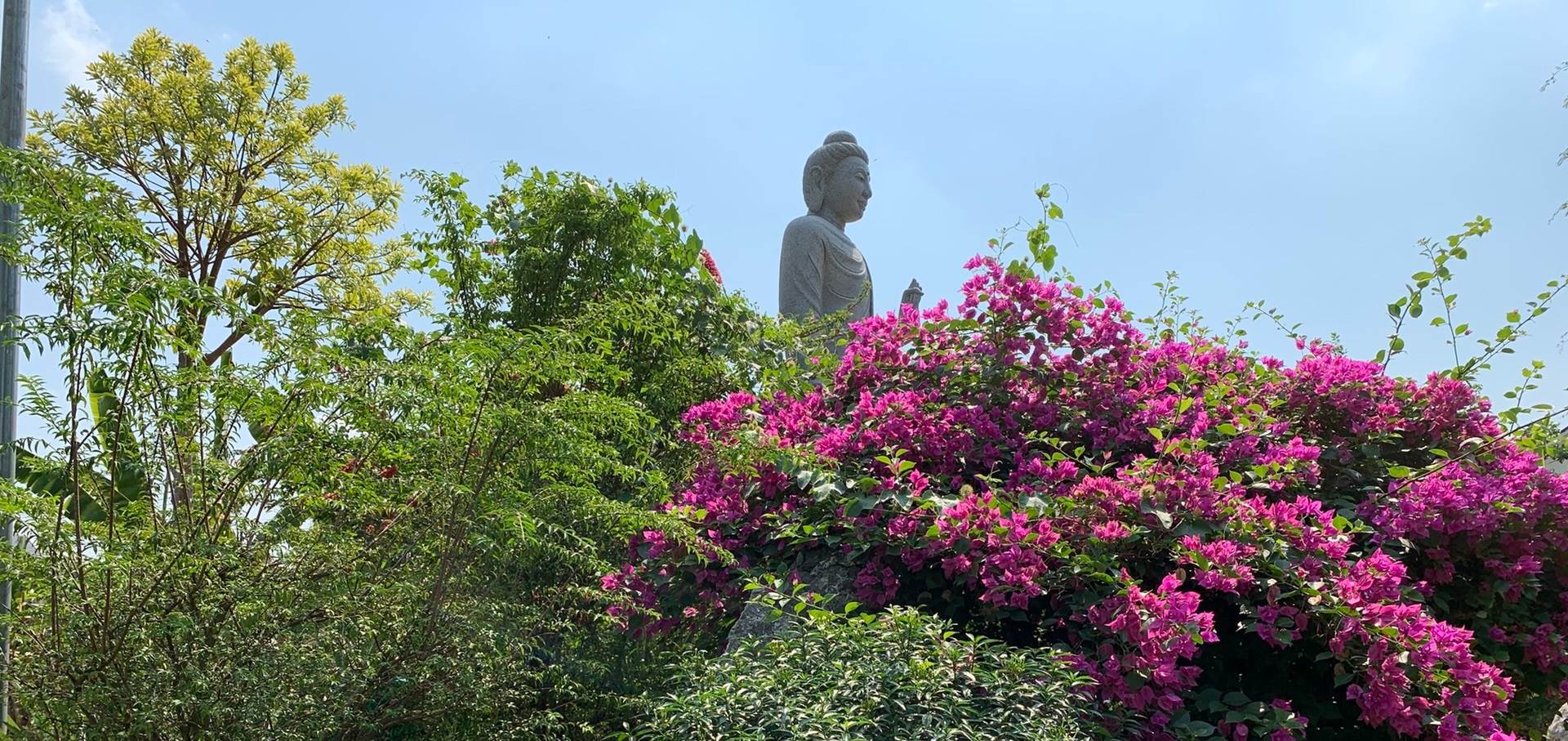
 28/04/2024
28/04/2024 86 views
86 views

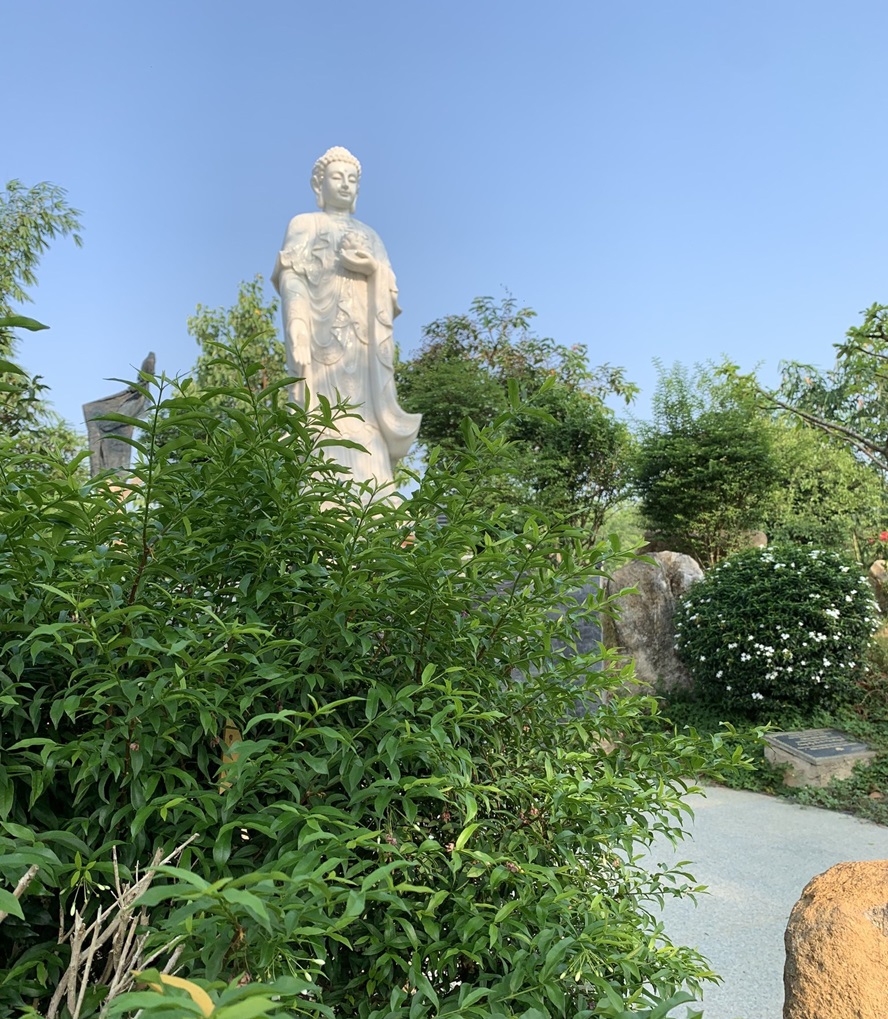
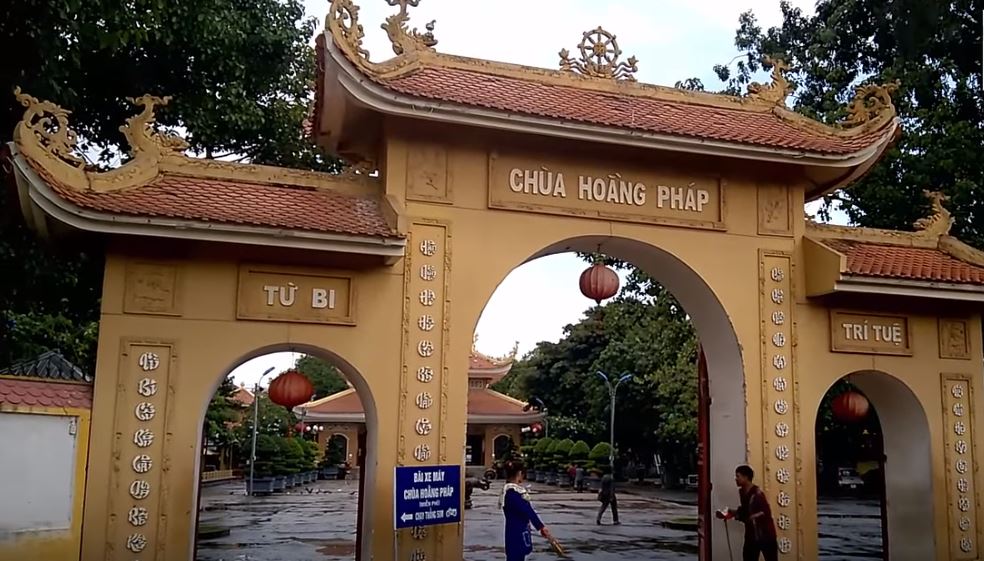

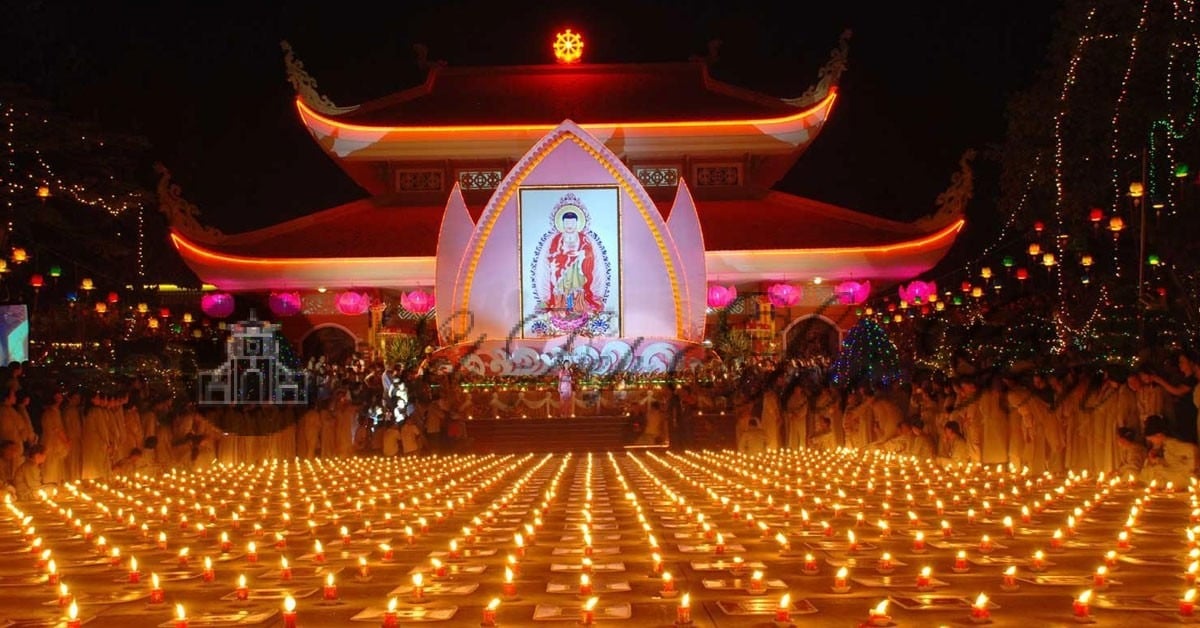
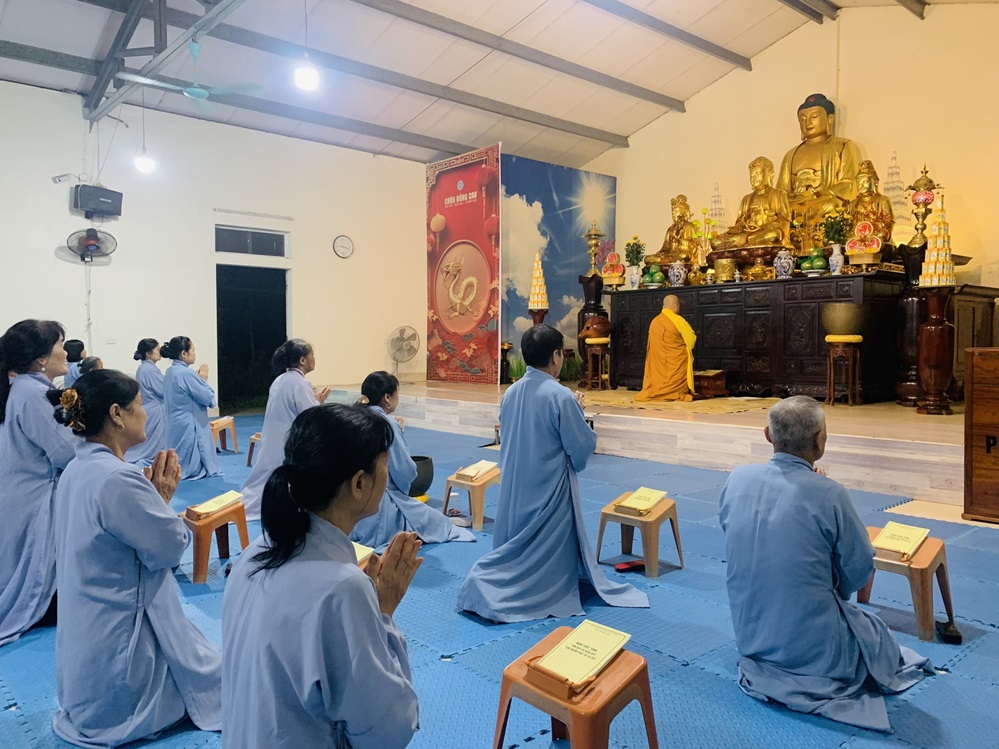





![[Summer Sale -10%] Best-value Vinpearl Safari & VinWonders Phu Quoc combo tickets – Unlimited access now available](https://static.vinwonders.com/production/banner-336x160.jpg)


